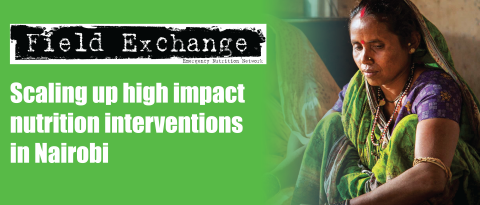Infant and young child feeding in emergencies: An analysis of key factors of a strong response
Summary of research1
Despite the evidence that appropriate and timely support of infant and young child feeding in emergencies (IYCF-E) saves lives, it is rarely prioritised or adequately supported. This study by the Save the Children Technical Rapid Response Team (Tech RRT) explores factors that supported or inhibited a strong IYCF-E response in three emergencies: the El Niño drought in Ethiopia 2015-2016; the earthquake in Nepal in 2015; and the ongoing Syrian crisis.
From 2015 to 2016 Ethiopia experienced its worst drought in 50 years, leaving 10.2 million people in need of emergency assistance by the end of 2015 and 420,000 children under five years old requiring treatment for severe acute malnutrition (SAM) in 2016. During the crisis a total of 1.1 million children aged 0-2 years old and 600,000 pregnant and lactating women (PLW) were targeted with IYCF-E interventions in 142 priority districts. The 2015 earthquake in Nepal led to a large humanitarian effort that reached 3.7 million people in the 14 severely affected districts, including 404,000 children aged six months to five years old and PLW in need of nutrition support. In Syria, by 2017, the ongoing conflict had left 13,6 million people requiring humanitarian assistance, including 4.9 million people trapped in besieged and hard-to-reach areas and an estimated 2.5 million children aged six months to five years and 1.9 million PLW; most infants among them were being fed infant formula, which presented particular challenges. The aim of this study was to identify common factors across these three different contexts that supported, and hindered, good IYCF-E response.
A panel of Save the Children Nutrition in Emergency Technical Advisors determined indicators defining strong IYCF-E programming and potential key underlying factors, drawing from existing indicators, such as Sphere Standards and Global Nutrition Cluster indicators. Secondary data was collected and 13 interviews conducted with key stakeholders from international non-governmental organisations (NGOs) (n=7), local NGOs (n=2), United Nations (UN) agencies (n=1) and the Nutrition Cluster (n=3) in October-November 2016 for Ethiopia, May-June 2017 for Syria and August-September 2017 for Nepal. Data was analysed and a score was attributed to each country based on the strength of the IYCF-E response out of a maximum possible score of 16 (<8 weak; 8-11 medium and >12 strong). Ethiopia scored 9 (medium); Nepal 11 (medium) and Northern Syria 13 (strong).2
The first factor identified as supportive of a good IYCF-E response across the three case studies was the activation of the Nutrition Cluster. In Northern Syria it was only after the Nutrition Cluster was activated that the response grew stronger; before this, nutrition was a working group of the Health Cluster and the IYCF-E response was weak. The second factor identified was the presence of a strong component on IYCF-E as part of the national IYCF strategy pre-crisis, which contributed to the strength and timeliness of the response in Nepal. Third, commitment of government and national and international NGOs to IYCF-E were important drivers, particularly in Nepal, where strong government commitment led to implementation of the International Code of Marketing of Breastmilk Substitutes and other important IYCF-E policies and strategies. In Northern Syria commitment of international NGOs enabled the capacity-building of national NGOs and engendered greater commitment to IYCF-E. Assessment of IYCF practices and needs was also important. This aspect was generally weak in the three case studies, although recent improvement was seen in Syria, which may have helped to strengthen the response. Another critical factor was the presence of pre-crisis IYCF programmes and availability of trained staff, important in the responses in Ethiopia and, in particular, Nepal. However, transition from IYCF to IYCF-E, such as the establishment of mother and baby areas to enable focused support to those affected, was not straightforward in either Ethiopia or Nepal and required advocacy among key stakeholders and capacity-building. Pre-crisis IYCF programmes and the availability of trained staff were weak in Northern Syria, which may partly explain the slow IYCF-E response. Finally, linking IYCF-E to health was also identified as key; in Northern Syria significant funds for the IYCF-E programme were raised by embedding within the health programme.
On the basis of these findings the authors put forward a set of recommendations for future IYCF-E response, described in Box 1.
Box 1: Recommendations for IYCF-E responses
1. Include IYCF-E in pre-crisis IYCF and nutrition policies, strategies and preparedness plans.
2. Conduct IYCF-E assessments so that needs are clearly defined.
3. Activation of the Nutrition Cluster should not depend solely on acute malnutrition prevalence but should also be justifiable on the grounds of IYCF-E.
4. Secure and support IYCF-E champions (such as the Ministry of Health, national and international NGOs and UN agencies) to raise awareness about IYCF-E and advocate for implementation of interventions when needed.
5. Strengthen pre-crisis IYCF interventions and coordinate with pre-crisis IYCF staff and programmes. Consider their views, experience and knowledge and orientate them on interventions and mechanisms specific to emergencies, such as mother-baby areas and Nutrition Cluster coordination, so that they are fully on board when additional IYCF-E activities are developed.
6. Prioritise awareness and capacity-building in IYCF-E by government and humanitarian agencies.
7. Reinforce links between IYCF-E and other sectors, especially health.
See Operational Guidance on infant and young child feeding in emergencies, v3, 2018 for more guidance on preparedness and response. https://www.ennonline.net/operationalguidance-v3-2017
Endnotes
1Technical rapid response team (Tech RRT) (2018). Infant and young child feeding in emergencies: an analysis of key factors of a strong response. www.ennonline.net/resource/iycfanalysisstrongresponse
2It should be noted that the score for Northern Syria was attributed based on the IYCF-E response as it was in 2017, which had improved considerably from the beginning of the crisis.


